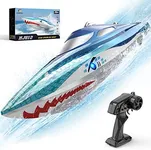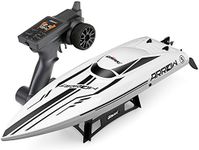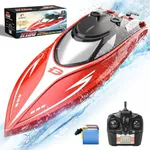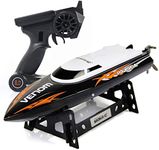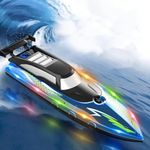Buying Guide for the Best Remote Control Boats
Choosing the right remote-control boat can be a fun and rewarding experience, whether you're looking for a relaxing hobby or an exciting racing challenge. The key is to match the boat's features to your interests and where you plan to use it. Think about whether you want speed, maneuverability, or just a simple, easy-to-use boat for casual play. Understanding the main specifications will help you make a choice that fits your needs and ensures you get the most enjoyment out of your purchase.SpeedSpeed refers to how fast the remote-control boat can travel, usually measured in kilometers per hour (km/h) or miles per hour (mph). This is important because it determines how thrilling and challenging your boating experience will be. Boats with lower speeds (under 15 km/h) are great for beginners and children, offering easy control and less risk of damage. Mid-range speeds (15-30 km/h) provide a good balance for casual users who want a bit more excitement. High-speed boats (over 30 km/h) are best for experienced users who enjoy racing and have the skills to handle quick maneuvers. Consider your comfort level and where you'll be using the boat—smaller ponds are better for slower boats, while larger lakes can accommodate faster models.
Control RangeControl range is the maximum distance the boat can travel from the remote before losing connection, typically measured in meters or feet. This is important because it affects how far you can explore with your boat. Short ranges (under 50 meters) are suitable for small pools or ponds, while medium ranges (50-150 meters) work well for larger bodies of water. Long ranges (over 150 meters) are ideal for open lakes or when you want to race over greater distances. Think about the size of the area where you plan to use the boat and choose a range that allows you to operate comfortably without losing control.
Battery LifeBattery life tells you how long the boat can run on a single charge, usually measured in minutes. This is important because it determines how much playtime you get before needing to recharge. Short battery life (under 15 minutes) is common in smaller or cheaper models and may require frequent breaks. Medium battery life (15-30 minutes) is good for most users, offering a decent amount of continuous fun. Longer battery life (over 30 minutes) is best for extended sessions or when you don't want to worry about recharging often. Consider how long you want to use the boat at a time and whether you’re willing to buy extra batteries for longer play.
Hull TypeThe hull type refers to the shape and design of the boat's body, which affects stability, speed, and maneuverability. There are generally three types: flat-bottom, deep-V, and catamaran. Flat-bottom hulls are stable and easy to control, making them great for beginners and calm waters. Deep-V hulls cut through water more efficiently, offering higher speeds and better handling in choppy conditions, which suits intermediate users. Catamaran hulls have two parallel sections, providing excellent stability and speed, ideal for racing and advanced users. Think about your skill level and the water conditions where you’ll use the boat to pick the right hull type.
Waterproofing and DurabilityWaterproofing and durability refer to how well the boat is protected against water damage and how sturdy it is against bumps or crashes. This is important because remote-control boats are often exposed to splashes, collisions, and sometimes even flips. Basic waterproofing is enough for calm, shallow water and gentle use, while enhanced waterproofing and reinforced materials are better for rougher conditions or high-speed racing. If you’re new to the hobby or plan to use the boat in unpredictable environments, look for models with good waterproof seals and durable construction to ensure a longer lifespan.
Self-Righting FeatureA self-righting feature allows the boat to flip itself back over if it capsizes. This is important because it saves you from having to retrieve the boat manually if it turns upside down, especially in deep or hard-to-reach water. Boats without this feature are fine for calm, shallow areas where you can easily recover them, but if you plan to use your boat in larger or rougher waters, a self-righting feature adds convenience and peace of mind. Consider how likely it is that your boat might flip and how easy it would be for you to recover it before deciding if this feature is necessary.
